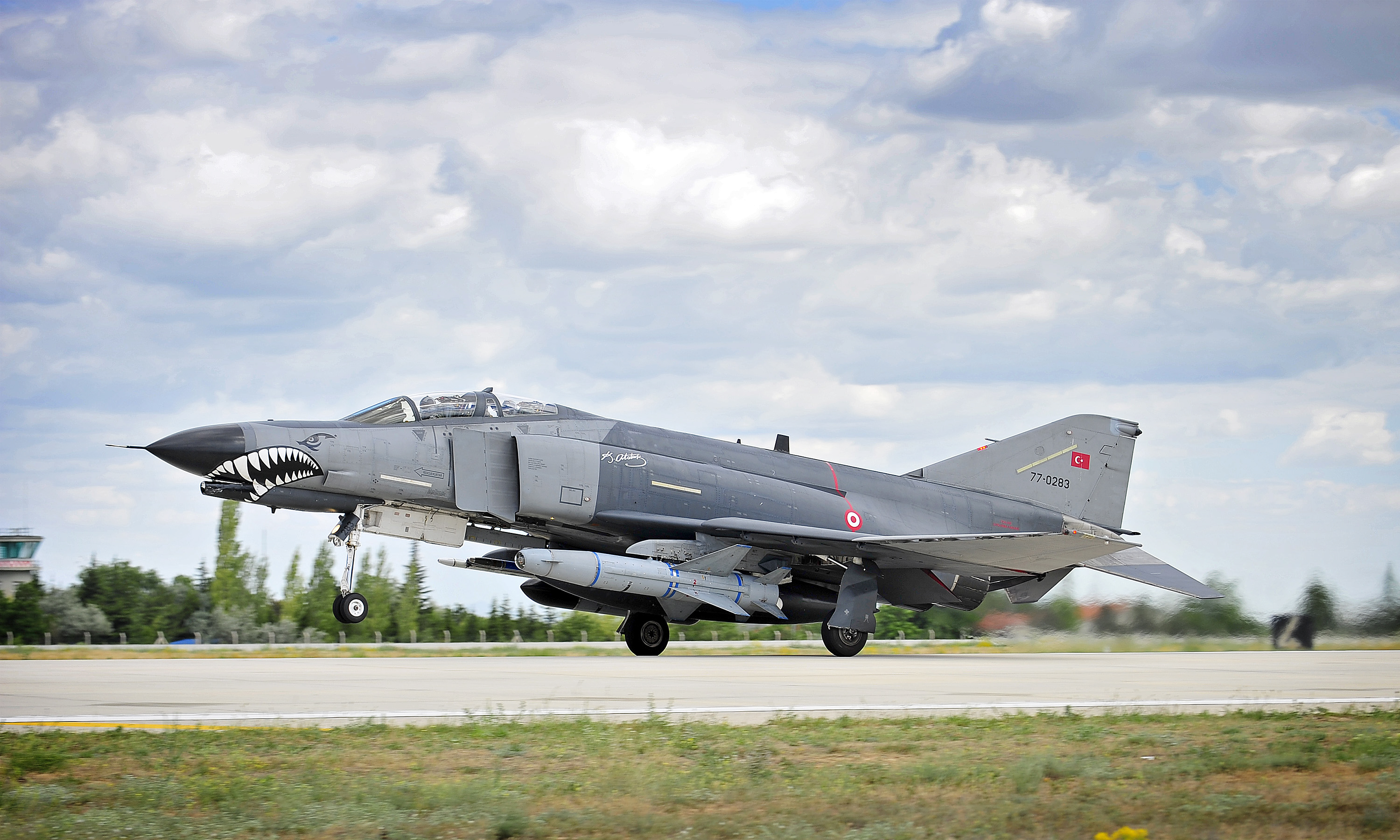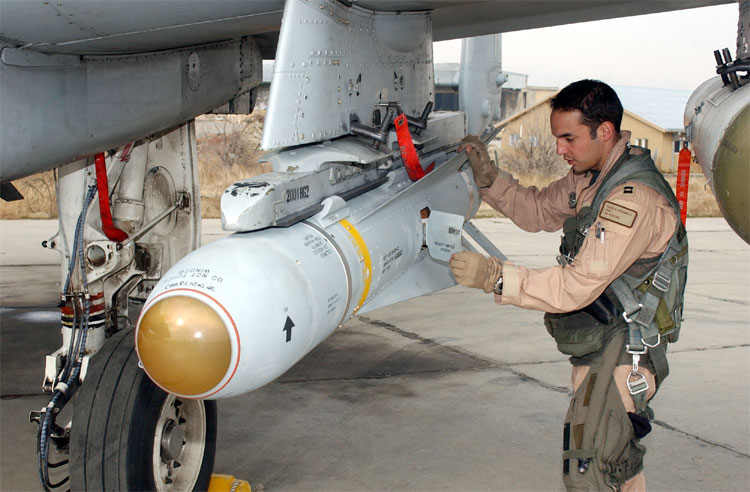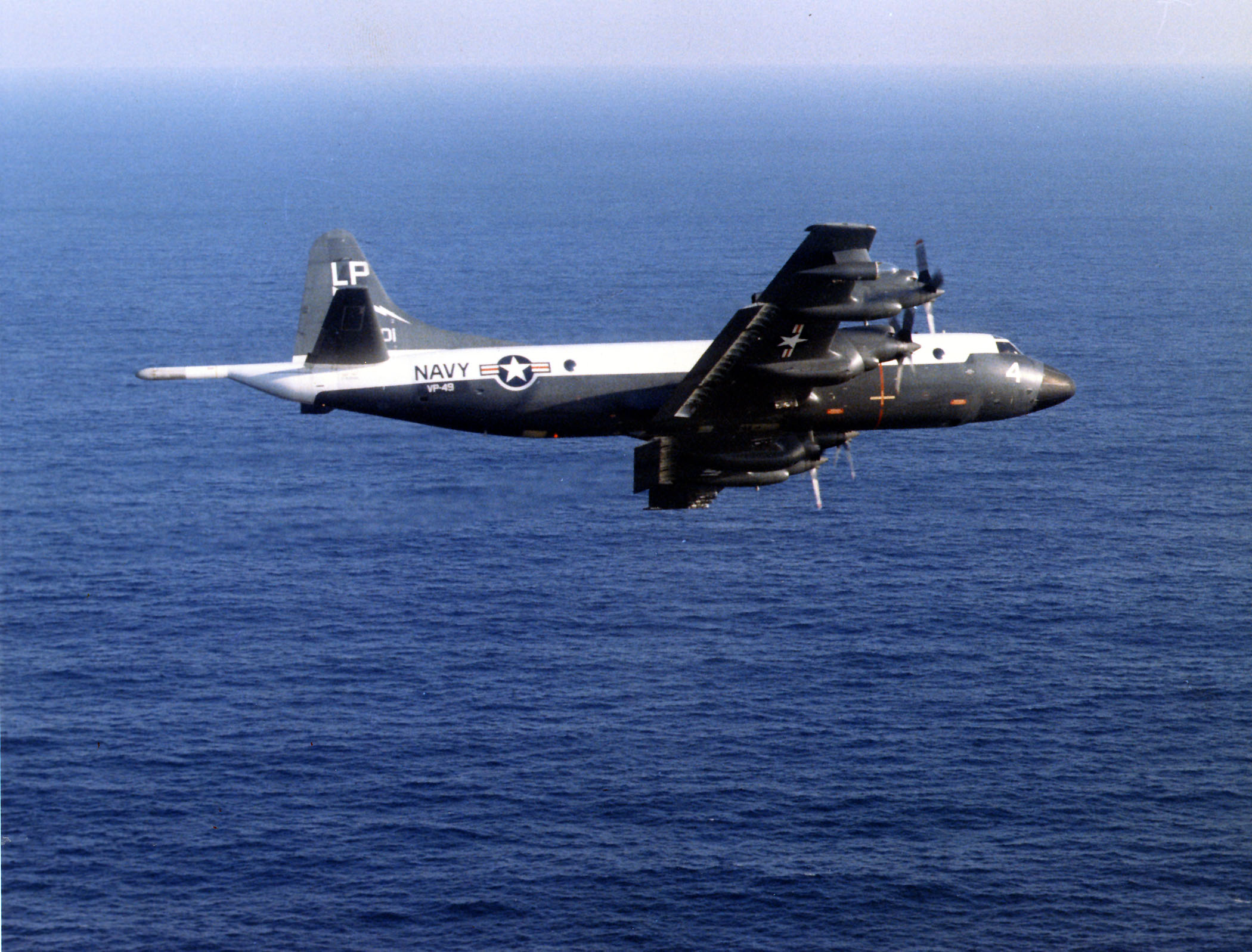|
Popeye (missile)
The Popeye (Hebrew: פופאי) is a family of air-to-surface missiles developed and in use by Israel, of which several types have been developed for Israeli and export users. A long-range submarine-launched cruise missile variant of the Popeye Turbo has been speculated as being employed in Israel's submarine-based nuclear forces.Israeli missile FAS The United States operated the Popeye under a different designation according to US naming conventions as the AGM-142 Have Nap. Design The Popeye is designed for precision attack against large targets from stand off ranges. The standard Popeye and smaller Popeye-Lite are powered by a single-stage |
Air-to-surface Missile
An air-to-surface missile (ASM) or air-to-ground missile (AGM) is a missile designed to be launched from military aircraft at targets on land or sea. There are also unpowered guided glide bombs not considered missiles. The two most common propulsion systems for air-to-surface missiles are rocket motors, usually with shorter range, and slower, longer-range jet engines. Some Soviet Union, Soviet-designed air-to-surface missiles are powered by ramjets, giving them both long range and high speed. Missile guidance, Guidance for air-to-surface missiles is typically via laser guidance, infrared homing, infrared guidance, optical guidance or via satellite guidance signals. The type of guidance depends on the type of target. Ships, for example, may be detected via passive radar or active radar homing, which is less effective against multiple, small, fast-moving land targets. There is some cross-over between air-to-surface missiles and surface-to-surface missiles. For example, there was ... [...More Info...] [...Related Items...] OR: [Wikipedia] [Google] [Baidu] |
Air-launched Cruise Missile
An air-launched cruise missile (ALCM) is a cruise missile that is launched from a military aircraft. Current versions are typically standoff weapons which are used to attack predetermined land and naval targets with conventional weapon, conventional, nuclear weapon, nuclear or thermonuclear weapon, thermonuclear payloads. Specific types of ALCMs (current, past and under development) include: *AGM-28 Hound Dog (USA) *AGM-84H/K SLAM-ER (USA) *AGM-86 ALCM (USA) *AGM-129 ACM (USA) *AGM-158 JASSM (USA) *AGM-158C LRASM (USA) *AGM-181 LRSO (USA) *Air-Sol Moyenne Portée ASMP (France) *AKF-98 (China) *ASN4G (France) *BrahMos (India/Russia) *BrahMos-II (India/Russia) *CJ-10 (missile), CJ-10 (China) *Delilah (missile), Delilah (Israel) *Hatf-VIII (Ra'ad) (Pakistan) *HAL Combat Air Teaming System#CATS Hunter, CATS Hunter (India) *Hypersonic Attack Cruise Missile (USA) *Hypersonic Air Launched Offensive Anti-Surface (USA) *Ra'ad-II (Pakistan) *Joint Strike Missile (Norway/USA) *3M-54 Klub, ... [...More Info...] [...Related Items...] OR: [Wikipedia] [Google] [Baidu] |
Submarine-launched Cruise Missiles
A submarine-launched cruise missile (SLCM) is a cruise missile that is launched from a submarine (especially a SSG or SSGN). Current versions are typically standoff weapons known as land-attack cruise missiles (LACMs), which are used to attack predetermined land targets with conventional or nuclear payloads. Anti-ship cruise missiles (ASCMs) are also used, and some submarine-launched cruise missiles have variants for both functions. History of development The U.S. Navy's first land-attack cruise missile submarines (4 SSG and 1 SSGN) deployed with the Regulus missile from 1958 until retired in 1964 with the arrival of the Polaris ballistic missile submarines (SSBNs) in the Pacific. The US deployed the short-range Harpoon anti-ship missile on submarines beginning in 1981. The Soviet Navy converted 13 Whiskey-class submarines (Project 613) for the land-attack cruise missile (LACM) role in the late 1950s (Whiskey Single Cylinder, Whiskey Twin Cylinder, Whiskey Long Bin), armed wit ... [...More Info...] [...Related Items...] OR: [Wikipedia] [Google] [Baidu] |
Tomahawk (missile Family)
The BGM-109 Tomahawk () Land Attack Missile (TLAM) is an American long-range, all-weather, jet-powered, Subsonic flight, subsonic cruise missile that is primarily used by the United States Navy and Royal Navy in ship and submarine-based land-attack operations. Developed at the Applied Physics Laboratory of Johns Hopkins University under James H. Walker near Laurel, Maryland, the Tomahawk emerged in the 1970s as a modular cruise missile first manufactured by General Dynamics. The Tomahawk aimed to fulfill the need for a medium- to long-range, low-altitude missile with diverse capabilities. Its modular design allows for compatibility with a range of warheads, including high-explosive, submunitions, and bunker-busters. The Tomahawk can use a variety of guidance systems, including Global Positioning System, GPS, Inertial navigation system, inertial navigation, and TERCOM, terrain contour matching. Over a dozen variants and upgraded versions have been developed since the original desi ... [...More Info...] [...Related Items...] OR: [Wikipedia] [Google] [Baidu] |
Dolphin-class Submarine
The ''Dolphin'' class () is a diesel-electric submarine developed in Israel and constructed by Howaldtswerke-Deutsche Werft (HDW) in Kiel, Germany, for the Israeli Navy's Shayetet 7 flotilla. The first boats of the class were based on the export-only German 209-class submarines, but modified and enlarged. The ''Dolphin'' 1 sub-class is slightly larger than the German Navy Type 212 in length and displacement. The three newer air-independent propulsion (AIP) equipped boats are similar to the Type 212 vessels in underwater endurance, but are longer, nearly 500 tonnes heavier in submerged displacement and have a larger crew than either the Type 212 or the Type 214. The ''Dolphin 2'' class submarines are the largest to have been built in Germany since World War II and the most expensive single vehicles in the Israel Defense Forces. The ''Dolphin'' class replaced the aging , which had served in the Israeli navy since the late 1970s. Each ''Dolphin''-class submarine is capable o ... [...More Info...] [...Related Items...] OR: [Wikipedia] [Google] [Baidu] |
Nuclear Deterrent
Nuclear strategy involves the development of doctrines and strategies for the production and use of nuclear weapons. As a sub-branch of military strategy, nuclear strategy attempts to match nuclear weapons as means to political ends. In addition to the actual use of nuclear weapons whether in the battlefield or strategically, a large part of nuclear strategy involves their use as a bargaining tool. Some of the issues considered within nuclear strategy include: *Conditions which serve a nation's interest to develop nuclear weapons *Types of nuclear weapons to be developed *How and when weapons are to be used Many strategists argue that nuclear strategy differs from other forms of military strategy. The immense and terrifying power of the weapons makes their use, in seeking victory in a traditional military sense, impossible. Perhaps counterintuitively, an important focus of nuclear strategy has been determining how to prevent and deter their use, a crucial part of mutually ... [...More Info...] [...Related Items...] OR: [Wikipedia] [Google] [Baidu] |
Second Strike
In nuclear strategy, a retaliatory strike or second-strike capability is a country's assured ability to respond to a nuclear attack with powerful nuclear retaliation against the attacker. To have such an ability (and to convince an opponent of its viability) is considered vital in nuclear deterrence, as otherwise the other side might attempt to try to win a nuclear war in one massive Pre-emptive nuclear strike, first strike against its opponent's own nuclear forces. Theory The possession of second-strike capabilities counters a first-strike nuclear threat and can support a no first use nuclear strategy. Reciprocal second-strike capabilities usually cause a mutual assured destruction defence strategy, though one side may have a lower level minimal deterrence response. Second-strike capabilities can be further strengthened by implementing fail-deadly mechanisms. These mechanisms create a threshold and guaranteed consequences if that threshold is breached. For instance, a threshold m ... [...More Info...] [...Related Items...] OR: [Wikipedia] [Google] [Baidu] |
Nuclear Warhead
A nuclear weapon is an explosive device that derives its destructive force from nuclear reactions, either fission (fission or atomic bomb) or a combination of fission and fusion reactions (thermonuclear weapon), producing a nuclear explosion. Both bomb types release large quantities of energy from relatively small amounts of matter. Nuclear bombs have had yields between 10 tons (the W54) and 50 megatons for the Tsar Bomba (see TNT equivalent). Yields in the low kilotons can devastate cities. A thermonuclear weapon weighing as little as can release energy equal to more than 1.2 megatons of TNT (5.0 PJ). Apart from the blast, effects of nuclear weapons include firestorms, extreme heat and ionizing radiation, radioactive nuclear fallout, an electromagnetic pulse, and a radar blackout. The first nuclear weapons were developed by the Allied Manhattan Project during World War II. Their production continues to require a large scientific and industrial complex, primari ... [...More Info...] [...Related Items...] OR: [Wikipedia] [Google] [Baidu] |
Kiloton
TNT equivalent is a convention for expressing energy, typically used to describe the energy released in an explosion. A ton of TNT equivalent is a unit of energy defined by convention to be (). It is the approximate energy released in the detonation of a tonne, metric ton (1,000 kilograms) of trinitrotoluene (TNT). In other words, for each gram of TNT exploded, (or 4184 joules) of energy are released. This convention intends to compare the destructiveness of an event with that of conventional explosive materials, of which TNT is a typical example, although other conventional explosives such as dynamite contain more energy. A related concept is the physical quantity TNT-equivalent mass (or mass of TNT equivalent), expressed in the ordinary unit of mass, units of mass and its multiples: kilogram (kg), megagram (Mg) or tonne (t), etc. Kiloton and megaton The "kiloton (of TNT equivalent)" is a unit of energy equal to 4.184 Metric prefix#List of SI prefixes, terajoules (). A kil ... [...More Info...] [...Related Items...] OR: [Wikipedia] [Google] [Baidu] |
Spice (bomb)
The "SPICE" ("Smart, Precise Impact, Cost-Effective") is an Israeli-developed, EO/ GPS- guidance kit used for converting air-droppable unguided bombs into precision-guided bombs. The featured guidance system is a derivative of the respective system used in the "Popeye" (AGM-142 Have Nap) air-to-surface missile. The "Spice" family of guided bombs are a product of an Israeli company Rafael Advanced Defense Systems. It achieved initial operational capability in 2003, in Israeli Air Force F-16 squadrons. Design The "Spice" guided bomb features technology not typically seen in most EO-guided bombs, such as the GBU-15. It combines the advantages of satellite guidance, allowing it to engage camouflaged and hidden targets, to provide a "drop-and-forget" option for several such targets simultaneously and operate in all weather and lighting conditions, and those of electro-optical guidance, such as the ability to provide " man-in-the-loop" guidance for higher precision. It has the ... [...More Info...] [...Related Items...] OR: [Wikipedia] [Google] [Baidu] |
Lockheed P-3 Orion
The Lockheed P-3 Orion is a four-engined, turboprop Anti-submarine warfare, anti-submarine and maritime patrol aircraft, maritime surveillance aircraft developed for the United States Navy and introduced in the 1960s. It is based on the Lockheed L-188 Electra, L-188 Electra commercial airliner by Lockheed Corporation, Lockheed; it is easily distinguished from the Electra by its distinctive tail stinger or "MAD" boom, used for the Magnetic anomaly detector, magnetic anomaly detection (MAD) of submarines. Over the years, the P-3 has seen numerous design developments, most notably in its electronics packages. Numerous navies and air forces around the world continue to use the type primarily for maritime patrol, reconnaissance, anti-surface warfare and anti-submarine warfare. A total of 757 P-3s have been built. In 2012, it joined the handful of military aircraft including the Boeing B-52 Stratofortress, Boeing KC-135 Stratotanker, and Lockheed C-130 Hercules that the United States m ... [...More Info...] [...Related Items...] OR: [Wikipedia] [Google] [Baidu] |
Global Positioning System
The Global Positioning System (GPS) is a satellite-based hyperbolic navigation system owned by the United States Space Force and operated by Mission Delta 31. It is one of the global navigation satellite systems (GNSS) that provide geolocation and time information to a GPS receiver anywhere on or near the Earth where there is an unobstructed line of sight to four or more GPS satellites. It does not require the user to transmit any data, and operates independently of any telephone or Internet reception, though these technologies can enhance the usefulness of the GPS positioning information. It provides critical positioning capabilities to military, civil, and commercial users around the world. Although the United States government created, controls, and maintains the GPS system, it is freely accessible to anyone with a GPS receiver. Overview The GPS project was started by the U.S. Department of Defense in 1973. The first prototype spacecraft was launched in 1978 an ... [...More Info...] [...Related Items...] OR: [Wikipedia] [Google] [Baidu] |






